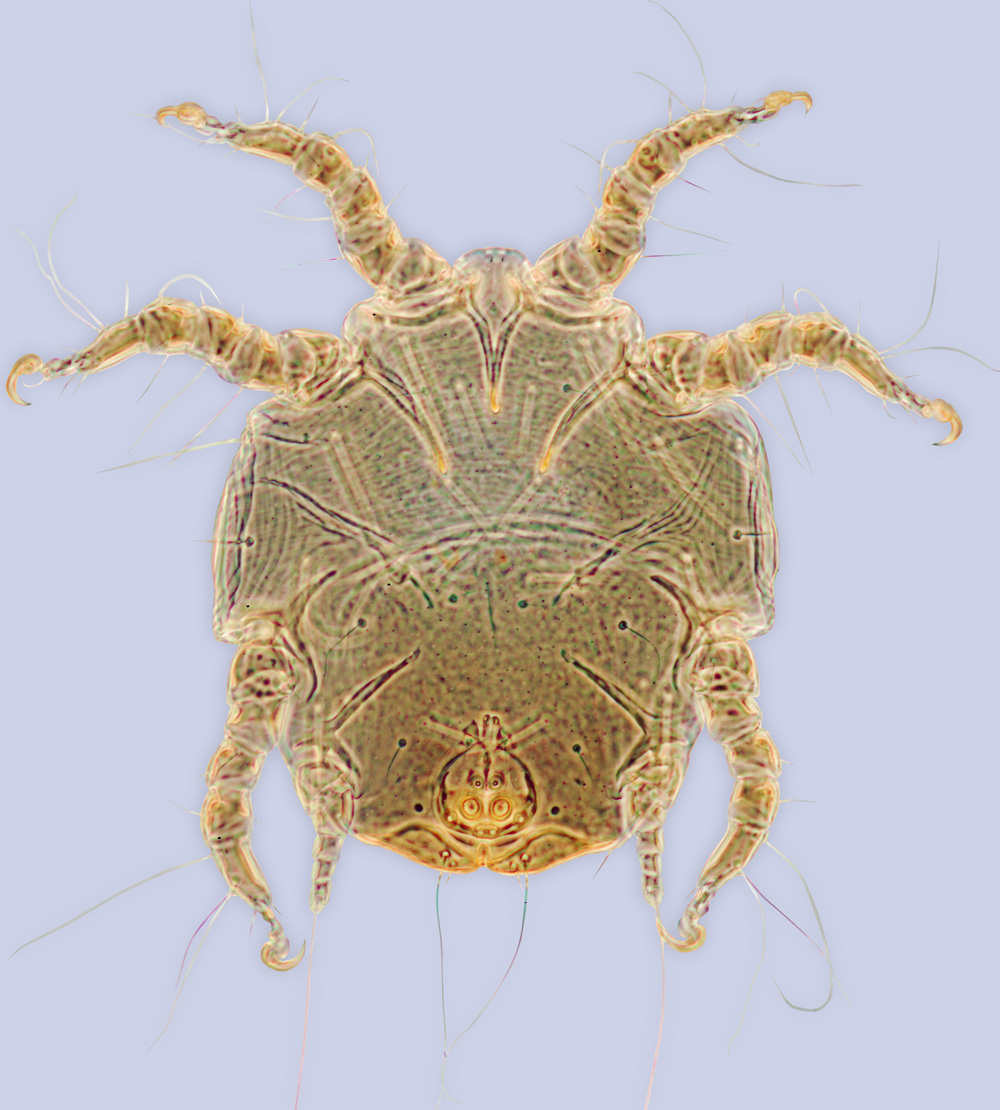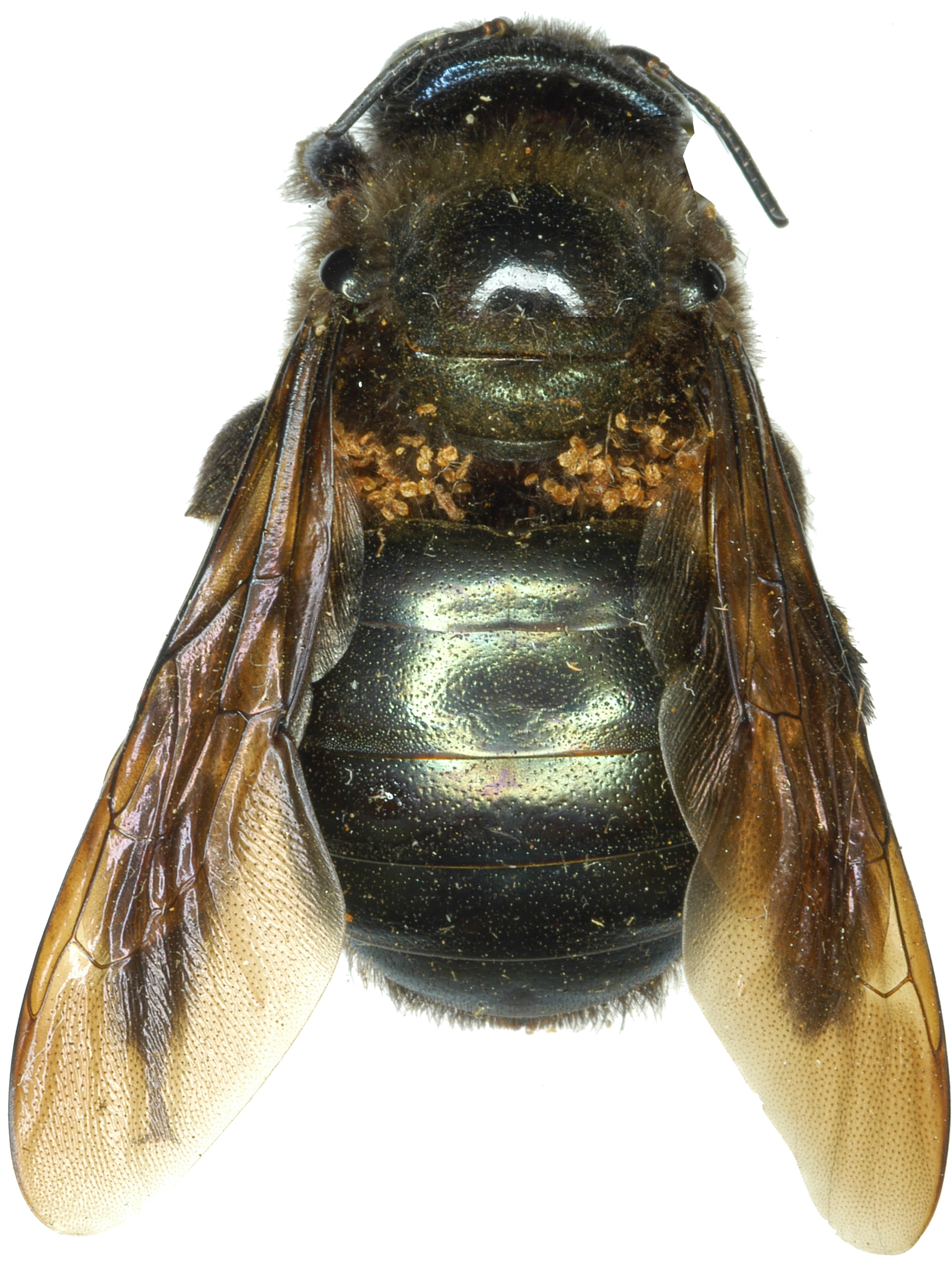Bee Mites : Acari : Acariformes : Sarcoptiformes : Chaetodactylidae : Sennertia : Sennertia species
Sennertia segnis Klimov and OConnor, 2008
Sennertia segnis Klimov & OConnor, 2008: 170, Figs 86-87
Material (show database records). Holotype: 1 HDN - USA: California, Tulare Co., 2 mi N Hartland [label reads Fresno Co., 2 mi N Hartland], Asclepias (Gentianales: Asclepiadaceae), ex Xylocopa californica californica wing bases, 24 Aug 1979, S. Muzzio, CAS, BMOC 03-0604-039. Paratypes: 7 HDNs - same data as holotype; 23 HDNs - Mendocino Co., Ryan Creek, N of Willits, ex X. tabaniformis orpifex (dorsal mesosoma), 10 May 1955, R. Craig, USNM, BMOC 05-0420-388; 1 HDN - Modoc Co., 4 mi S Lake City, ex X. c. californica on propodeum, 9 Jul 1946, P. D. Hurd, R. F. Smith, UMMZ BMOC 04-0810-003; 7 HDNs - Riverside Co., Banning, ex X. c. arizonensis wing bases, 28 May 1928, E. C. Van Dyke, CAS BMOC 03-0604-038; 15 HDNs - Riverside Co., Keen Camp, ex X. c. diamesa on lateral propodeum, 24 May 1946, D. J. & J. N. Knulle OSU 0121529, BMOC 03-1106-070; 13 HDNs - San Bernardino Co., Seven Oaks, ex X. c. arizonensis posterior wing bases, 25 May 1936, G. M. Kohls, FMNH, BMOC 03-0630-033; 2 HDNs - San Diego Co., Cuyamaca, ex X. c. arizonensis on propodeum, 1 May 1934, E. E. Seibert, UMMZ, BMOC 04-0810-002; 9HDNs - Arizona, Pima Co., Tucson, ex f X. californica propodeum & posterior wing bases, 1 Jun 1917, Oslar, INHS Insect Collection 62339, BMOC 04-1222-002; 21 HDNs - same locality, ex X. californica propodeum, 1 Jun 1917, Oslar, INHS Insect Collection 62495, BMOC 04-1222-155; 1 HDN - Patagonia Mountains, ex X. californica propodeum & posterior wing bases, 1 Jun 1917, Oslar, INHS Insect Collection 62340, BMOC 04-1222-003; 2 HDNs - MEXICO: Michoacán de Ocampo, Carapan, ex X. cyanea, on mesosoma, 1 Sep 1962 D. M. Janzen, USNM, BMOC 05-0420-130; 9HDNs - Puebla, Tehuacan, ex X. cyanea on axillar areas, no date, A. Heyne, USNM, BMOC 05-0420-129. Holotype in CAS, paratypes in CAS, FMNH, INHS, OSAL, UMMZ, UNAM, USNM.
Description. Phoretic deutonymph. Gnathosomal solenidia shorter than 1/3 of femur I width. Supracoxal setae scx situated on separate small sclerite. Hysterosomal shield lateral gland openings and bases of f2 nearly on edge of hysterosomal shield, or the former outside the shield. Lateral edges of hysterosomal shield in anterior part not narrowing. Dorsal hysterosomal pouch absent. Distance between anterior margin of hysterosomal shield and setae si exceeds diameter of si bases. Striate pattern of idiosomal cuticle outside hysterosomal shield without sclerotization, formed by long striae. Distinct rudiments of vi present. Setae si distinctly posterior se, exceed 1/2 of se, almost as thick as se. Diameter of si exceeds 1/2 of diameter of se. Setae c1 subequal to or less than 1. 3 times longer than d1; distinctly longer than h1; long, nearly as long as se; situated anterior to hysterosomal shield. Setae d1 and e1 distinctly longer than h1. Setae d1 situated on hysterosomal shield. Sclerite between ia and d2 absent. Setae e2 subequal with d2, not touching hysterosomal shield. Lateral gland openings situated outside hysterosomal shield. Setae 4b, g, and 4a without distinct rhomb-like, filiform. Setae 4b, pR I-II, sR III, wF IV, gT I-II, hT I-II, kT III, ra I-II, and wa I-II filiform. Posterior apodemes II and anterior apodemes III free. Posterior processes of coxal apodemes IV non-applicable. Anterior apodemes IV not interrupted, almost straight. Posterior apodeme IV absent. Conoids ps2 posterior to anterior transverse level of central suckers (ad1+2); anterior to ps1, situated outside outer level of ad1+2. Transparent margin of anterior suckers (ad3) without rough sclerotization. Suckers ad3 not enlarged, smaller than central suckers. Posterior and lateral borders of attachment organ not forming distinct frame. Sclerotized rudiment of anterior cuticular suckers absent. Longitudinal hysterosomal sclerite present, short. Ventral hysterosoma smooth. Genual setae mG I-II simple, mG II distinctly shorter than leg II, but longer than femur II. Tarsal setae la I-II longer than famulus ε. Tarsal setae ra I-II bifid, blade-like. Tarsal setae wa I-II and s III filiform, needle-like, or widened basally but with attenuated end. Tarsal setae d I-II slightly widened. Tarsal setae d and f I-II almost symmetrical, not touching. Solenidion ω3 closer to f I than to ω1. Posterior condylophore present. Anterior condylophore I-II with distal bending. Seta d III situated close to tarsal base, distance usually subequal or shorter than diameter of d III alveolus. Leg IV protruding posterior edge of hysterosoma. Tarsus IV not enlarged, shorter or less than 2 times longer than width of trochanter IV. Setae w IV thinner than d IV and distinctly shorter than leg IV, situated on middle of tarsus IV. Setae s IV present. Setae wF IV almost reaching or slightly protruding apex of tarsus IV.
Other instars unknown (tritonymph was observed inside pharate HDN but it cannot be fully described).
Distribution (Show map). USA: Arizona, California (type locality); Mexico: Michoacán de Ocampo, Puebla.
Hosts. Xylocopa (Xylocopoides) californica, Xylocopa (Xylocopoides) californica arizonensis, Xylocopa (Xylocopoides) californica diamesa, Xylocopa (Xylocopoides) cyanea, Xylocopa (Notoxylocopa) tabaniformis orpifex.
Etymology. Segnis (=slow, tardy) is a Latin adjective.
References
Klimov, P. B. & B. M. OConnor. 2008. Morphology, evolution, and host associations of bee-associated mites of the family Chaetodactylidae (Acari: Astigmata), with a monographic revision of North American taxa. Miscellaneous Publications Museum of Zoology University of Michigan.199: 1-243.
Image Gallery
B. OConnor and P. Klimov ©
Created: May 26, 2011
Last modified: 


